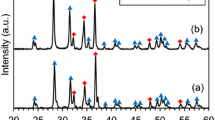The kinetics of sintering and phase interactions in the diffusion contact zones of Cr3C2 and ZrB2 are investigated. It is found that using Cr3C2 as a sintering activator for ZrB2 sintering reduces the hot pressing temperature from 2200°C to 1500–1750°C, depending on the Cr3C2 content. The phase formation accompanied with the formation of new high-temperature refractory compounds, such as zirconium carboborides, chromium borides and carboborides, and zirconium-chromium carboborides, rapidly develops at the Cr3C2 and ZrB2 interface within the diffusion zone. An intense diffusion of chromium and carbon into zirconium diboride accompanied with the formation of nonporous states in zirconium diboride (to a depth of 50–100 μm at 1360°C) near diffusion contact zone is observed. It is established that the contact interaction during sintering in the diffusion zone results in the formation of the vanishing eutectic liquid phase, which is consumed to forming new high-refractory compounds (phases based on zirconium carbide and chromium borides).













Similar content being viewed by others
References
A. Belossi, S. Guicciardi, V. Medri, et al., “Processing and properties of ultra-refractory composites based on Zr- and Hf-borides: state of the art and perspectives,” in: Boron Rich Solids: Sensors, Ultra High Temperature Ceramics, Thermoelectrics, Armor, N. Orlovskaya and M. Lugovy (eds.), Springer Netherlands, Dordrecht (2011), pp. 147–160.
N. D. Bega, V. B. Vinokurov, O. N. Grigoriev, et al., Study of Compaction Kinetics for ZrB 2 –Cr 3 C 2 -Based Materials during Hot Pressing; III International Samsonov Conference (May 2012, Kiev, Ukraine), Kiev (2012), p. 120.
3. V. G. Kayuk and V. A. Maslyuk, “Structure formation in alloys of the Cr3C2–TiN system and the properties of materials based on them,” Powder Metall. Met. Ceram., 43, Nos. 1–2, 39–43 (2004).
A. K. Shurin and V. E. Panarin, “State diagrams and the structure of alloys in Cr–ZrB2 and Cr–HfB2 quasibinary systems,” Dokl. AN USSR, Series A, No. 1, 87–90 (1975).
O. N. Grigoriev, V. A. Galanov, V. A. Kotenko, et al., “Mechanical properties of ZrB2–SiC(ZrSi2) ceramics,” J. Europ. Ceram. Soc., 30, 2173–2181 (2010).
V. M. Zalkin, Eutectics and Contact Melting Effect [in Russian], Metallurgiya, Moscow (1987), p. 152.
Author information
Authors and Affiliations
Corresponding author
Additional information
Translated from Poroshkovaya Metallurgiya, Vol. 55, Nos. 3–4 (508), pp. 77–89, 2015.
Rights and permissions
About this article
Cite this article
Grigoriev, O.N., Vinokurov, V.B., Klimenko, L.I. et al. Sintering of Zirconium Diboride and Phase Transformations in the Presence of Cr3C2 . Powder Metall Met Ceram 55, 185–194 (2016). https://doi.org/10.1007/s11106-016-9793-0
Received:
Published:
Issue Date:
DOI: https://doi.org/10.1007/s11106-016-9793-0




